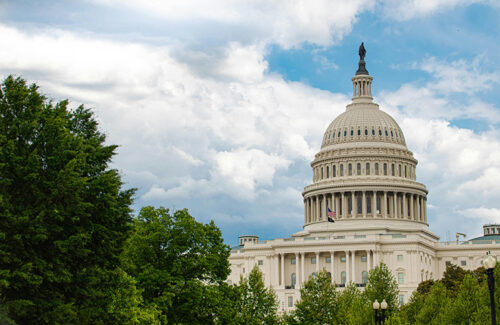 The Biden administration has unleashed a flurry of renewable energy activity since taking office in 2021, with official pledges to build more clean energy combined with massive stimulus in the Inflation Reduction Act. Biden has taken more climate actions than any president before him, An said analysis by more than twenty climate groupsincluding the youth-led Sunrise Movement.
The Biden administration has unleashed a flurry of renewable energy activity since taking office in 2021, with official pledges to build more clean energy combined with massive stimulus in the Inflation Reduction Act. Biden has taken more climate actions than any president before him, An said analysis by more than twenty climate groupsincluding the youth-led Sunrise Movement.
“He signed a landmark bill into law that will bring jobs back to the U.S. and revitalize communities, while cutting a billion tons of carbon pollution,” Lori Lodes, executive director of Climate Power, said in a news release.
With Biden out of the race and the next presidential election just months away, many are wondering whether the administration’s incentives, which are beginning to ramp up domestic solar production and development, are in jeopardy.
The answer is a bit complicated. A few possible scenarios could produce very different outcomes — for example, whether Democrats retain control of the White House and a majority in the Senate, or Republicans take over both, one, or neither.
Presumptive Democratic presidential nominee Kamala Harris clearly supported the IRA in her role as vice president, but some think she may push the green energy lever even further as head of her own government.
“She was born and raised in California, where in some ways the clean energy revolution began,” said Jillian Blanchard, director of the coalition of law firms’ Climate Change and Environmental Justice Program. Lawyers for good governance (L4GG). “I think she sees not only the need to protect our planet, but also the benefits in terms of workforce development [and] employment opportunities. I think she is also committed to the cause of environmental justice, which is a big part of Biden’s platform and which I think she will continue and hopefully expand.”
As a U.S. senator, Harris introduced the Climate Shares Act And Clean School Buses Actand co-sponsored the Green New Deal to transition the country to 100% clean energy.
“Vice President Harris has been an integral part of the Biden administration’s key climate achievements and has a long track record as an impactful climate champion,” Lena Moffitt, executive director of the nonprofit climate group Evergreen Action, said in a news release. “We are confident she is ready to continue President Biden’s historic legacy and set a new high bar for America’s climate ambition.”
IRA prospects if Republicans win
 While the IRA would likely be preserved under a Harris presidency, Republican nominee Donald Trump called President Biden’s agenda a “Green New Scam” and said at the 2024 Republican National Convention that he would refocus climate-related funding, according to The hill. But it may not be so easy to implement even if Trump assumes the presidency.
While the IRA would likely be preserved under a Harris presidency, Republican nominee Donald Trump called President Biden’s agenda a “Green New Scam” and said at the 2024 Republican National Convention that he would refocus climate-related funding, according to The hill. But it may not be so easy to implement even if Trump assumes the presidency.
“A substantial or final decision would be required [Republican] victory by margin to bring about meaningful change in the IRA,” said Matt Breidert, senior portfolio manager at renewable energy investment firm Ecofin. “Without the House, Senate and presidency, it will be difficult to materially change the IRA.”
If there is a Republican victory, some elements of the IRA will likely be safer from slashes than others. Breidert said it would be difficult for Republicans to eliminate domestic production credits for renewable energy.
Many of the new solar production announcements coming out of the IRA are benefiting red states, with investments by NorSun in Oklahoma, PV Hardware in Texas, and ReCreate in Tennessee, to name a few examples.
“The Republican Party really wants to do more and more reshoring,” Breidert said.
SEIA President and CEO Abigail Ross Hopper has spent a lot of time on Capitol Hill making sure lawmakers understand the impact of these credits in their states and districts. She has also raised concerns about Chinese imports by pointing to the manufacturing progress made in the United States thanks to the IRA.
“If we want to address Chinese influence on the solar and storage industries, we need to support domestic manufacturing, and that comes through this tax credit,” Hopper said.
In addition to the hometown advantages and independence from China, it was determined by the Congressional Budget Office that domestic production credits would be a relatively inexpensive budget allocation.
“If you look at the cost of the industry tax credits, they are actually very low compared to the entire IRA funding size. So our view is that we don’t think that the tax credits for manufacturing, the production of solar or wind equipment, would be at great risk,” Breidert said.
Numerous manufacturers in the solar supply chain – including those that make modules, inverters, racks and more – have cited the IRA as the reason they are moving their manufacturing operations to the United States. Without the tax credits they would most likely not have been able to make this step.
“We need investors who are willing to say, ‘Yes, I’m going to take a chance on this because I know I can get returns,’” said Leslie Chang, director of strategy and policy at US perovskite startup Caelux, which recently opened a 100 MW plant outside Los Angeles. “These manufacturing tax credits have significantly reduced risks in the markets so we can achieve that level of investment.”
ITC and PTC could be at risk
 While the industry tax credit is likely the safest IRA incentive in Republican hands, both Breidert and Hopper agree that the ITC and PTC may be more at risk.
While the industry tax credit is likely the safest IRA incentive in Republican hands, both Breidert and Hopper agree that the ITC and PTC may be more at risk.
“The manufacturing tax credit, I would say, has the most sustainability. The pots of money lying around and not being spent have the least sustainability,” Hopper said.
Breidert said reallocating the money set aside for the ITC and PTC would help Republicans expand tax credits they passed in 2017 that are set to expire at the end of 2025, including property tax exemptions and corporate tax exemptions.
But even if Republicans have the power to scrap the ITC and PTC, Breidert believes they won’t immediately end the program, but instead shorten their lifespan from 2032 to 2026 or 2028.
“We don’t think there’s much risk of them abruptly ending credits for wind and solar. They are very popular, widely implemented and enjoyed on a bipartisan basis,” he said. “Many economic interests in rural areas benefit from these tax credits.”
Hopper and SEIA are working hard to keep this top of mind among lawmakers.
“It wasn’t that long ago that there was a consensus among Republicans and Democrats that this creates jobs,” she said. “If you look at the amount of private investment coming from the ITC, those are staggering figures. It has an incredible multiplier effect.”
Law firm coalition L4GG has helped many cities adopt the ITC through the new direct pay provision, and is seeing how popular it is across all demographics.
“I work with cities across the country in red and blue and very red states that are taking advantage of tax breaks — in Ohio, in Missouri, in Indiana,” L4GG’s Blanchard said. “I don’t think these cities would be very happy if these things were pulled away.”
Regardless of what happens with the IRA, Breidert believes renewable energy will still flourish as the country moves quickly toward clean electrification. Shortening the time limit for the stimulus measures will only accelerate job losses.
“We see that the uncertainty is difficult,” he said. “If there was actually a change in the IRA in a shortening of the tax credit period … then obviously you would see a lot of progress and a lot of activity. People rushed to try to get many projects done quickly. So ironically, this could lead to a small boom in the short term, as we have seen in other cycles where ITCs and PTCs expire.”


